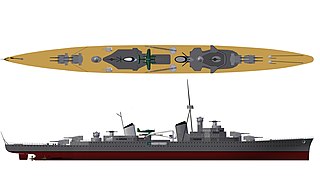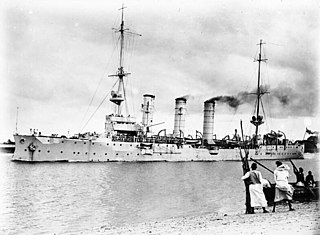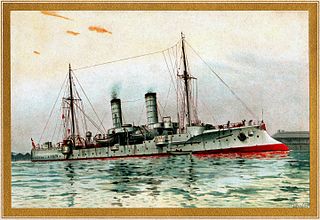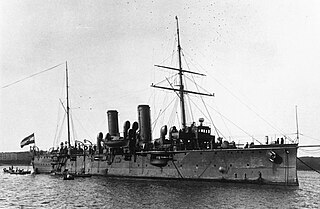
The Königsberg class, sometimes referred to as the K class, was a class of light cruisers of the German Reichsmarine and Kriegsmarine. The class comprised three ships named after German cities: Königsberg, Karlsruhe, and Köln, all built between 1926 and 1930. These ships were the first of the Reichsmarine with a modern cruiser design; their predecessor, Emden, was based on World War I-era designs. They were armed with a main battery of nine 15 cm (5.9 in) guns and with twelve 50 cm (20 in) torpedo tubes.

The O class was a planned class of three battlecruisers for the Kriegsmarine before World War II. Prompted by a perceived lack in ship numbers when compared with the British Royal Navy, the O class' design was born with the suggestion of modifying the P-class cruiser design with 380 mm (15 in) guns instead of 283 mm (11.1 in).
The P class was a planned group of twelve heavy cruisers of Nazi Germany's Kriegsmarine; they were the successor to the Deutschland-class cruisers. Design work began in 1937 and continued until 1939; at least twenty designs were submitted with nine of them being considered. There were three designs that were selected as the final contenders. One design was armed with six 283mm main guns in one triple turret forward and one more turret aft. It had two 150mm double secondary gun turrets as secondary armament with one being positioned above and just fore of the aft of the main 283mm main turret, and the other being in front and lower of the front main gun turret. This design had more beam than the other 2 designs. It also mounted 2 seaplanes on its fantail instead of the mid ship area. The final design was armed with six 28 cm (11 in) quick-firing guns in two triple turrets, as in the preceding Deutschland class. The ships were designated as Panzerschiff, and given the preliminary names P1–P12. They were an improved design over the preceding planned D-class cruisers, which had been canceled in 1934. Although the ships were already assigned to shipyards, construction never began on the P-class ships after the O-class battlecruiser design superseded them.

The M-class cruisers were a class of light cruisers planned, but never built, by Nazi Germany's Kriegsmarine before World War II. The ships were designed for commerce raiding in the Atlantic Ocean. The design for the first four ships suffered from a number of problems, and so the fifth and sixth ships were substantially redesigned.

The Cöln class of light cruisers was Germany's last class commissioned before her defeat in World War I. Originally planned to comprise ten ships, only two were completed; Cöln and Dresden. Five more were launched, but not completed: Wiesbaden, Magdeburg, Leipzig, Rostock and Frauenlob, while another three were laid down but not launched: Ersatz Cöln, Ersatz Emden and Ersatz Karlsruhe. The design was a slightly modified version of the preceding Königsberg class.

The Wiesbaden class of light cruisers was a class of ships built by the German Kaiserliche Marine shortly before the outbreak of World War I. Two ships were built in this class, Wiesbaden and Frankfurt. They were very similar to the preceding design, the Graudenz class, though they were armed with eight 15 cm SK L/45 guns instead of the twelve 10.5 cm SK L/45 guns on the earlier vessels. The ships had a top speed of 27.5 knots.

The Brummer class consisted of two light mine-laying cruisers built for the Imperial German Navy in World War I: SMS Brummer and SMS Bremse. When the war broke out, the Germans had only two older mine-laying cruisers. Although most German cruisers were fitted for mine-laying, a need for fast specialized ships existed. The Imperial Russian Navy had ordered sets of steam turbines for the first two ships of the Svetlana-class cruisers from the AG Vulcan shipyard in Stettin. This machinery was confiscated on the outbreak of war and used for these ships. Both vessels were built by AG Vulcan.

The Königsberg class was a group of four light cruisers built for the German Imperial Navy. The class comprised four vessels: SMS Königsberg, the lead ship, SMS Nürnberg, SMS Stuttgart, and SMS Stettin. The ships were an improvement on the preceding Bremen class, being slightly larger and faster, and mounting the same armament of ten 10.5 cm SK L/40 guns and two 45 cm (17.7 in) torpedo tubes.
The Ersatz Yorck class was a group of three battlecruisers ordered but not completed for the German Kaiserliche Marine in 1916. The three ships had originally been ordered as additions to the Mackensen class, but developments abroad, particularly the British Renown-class battlecruisers, led to the navy re-designing the ships. The primary change was an increase of the main battery from eight 35-centimeter (14 in) guns to eight 38 cm (15 in) weapons. Work on the first ship had already begun by the time the navy decided to re-design the ships, so the design staff was constrained by the need to use the material already assembled.

The Königsberg class of light cruisers was a group of four ships commissioned into Germany's Kaiserliche Marine shortly before the end of World War I. The class comprised Königsberg, Karlsruhe, Emden, and Nürnberg, all of which were named after light cruisers lost earlier in the war. The ships were an incremental improvement over the preceding Wiesbaden-class cruisers, and were armed with a main battery of eight 15 cm (5.9 in) SK L/45 guns and had a designed speed of 27.5 knots.

The Karlsruhe class of light cruisers was a pair of two ships built for the German Imperial Navy before the start of World War I. The ships—SMS Karlsruhe and Rostock—were very similar to the previous Magdeburg-class cruisers, mounting the same armament and similar armor protection, though they were larger and faster than the earlier ships. Both vessels were laid down in 1911, and launched one day apart, on 11 and 12 November 1912. Karlsruhe joined the fleet in January 1914, but fitting out work lasted slightly longer on her sister; Rostock was commissioned the following month.

The Pillau class of light cruisers was a pair of ships built in Germany just before the start of World War I. The class consisted of SMS Pillau and Elbing. The ships were initially ordered for the Imperial Russian Navy in 1912, and were built by the Schichau-Werke shipyard in Danzig. After the outbreak of World War I, however, the German Kaiserliche Marine confiscated the ships before they were completed. The ships were similar in design to other German light cruisers, although they lacked an armored belt. They were the first German light cruisers to be equipped with 15 cm SK L/45 guns, of which they carried eight. The two ships had a top speed of 27.5 knots.

The D-class cruisers were a pair of German heavy cruisers, classified as panzerschiffe by the Reichsmarine. The ships were improved versions of the preceding Deutschland-class cruisers, authorized by Adolf Hitler in 1933. They were intended to counter a new French naval construction program. Displacement increased to 20,000 long tons (20,000 t), but Hitler allowed only increases to armor, prohibiting additions to the ships' main battery armament. Only one of the two ships was laid down, but work was canceled less than five months after the keel was laid. It was determined that the designs should be enlarged to counter the new French Dunkerque-class battleship. The construction contracts for both ships were superseded by the Scharnhorst-class battleships.

The Gazelle class was a group of ten light cruisers built for the Imperial German Navy at the turn of the 20th century. They were the first modern light cruiser design of the Imperial Navy, and set the basic pattern for all future light cruisers in Imperial service. The design of the Gazelle class attempted to merge the fleet scout with the colonial cruiser. They were armed with a main battery of ten 10.5 cm (4.1 in) guns and a pair of torpedo tubes, and were capable of a speed of 21.5 knots.

The Kolberg class was a group of four light cruisers built for the German Imperial Navy and used during the First World War. The class comprised four vessels: SMS Kolberg, the lead ship, Mainz, Cöln, and Augsburg. The ships were built between 1908 and 1910, and two, Kolberg and Augsburg, were modernized in 1916–1917. The ships were armed with a main battery of twelve 10.5 cm SK L/45 guns and had a design speed of 25.5 knots. The first three ships were assigned to the reconnaissance forces of the High Seas Fleet; Augsburg was instead used as a torpedo and gunnery training ship.

The H class was a series of battleship designs for Nazi Germany's Kriegsmarine, which were intended to fulfill the requirements of Plan Z in the late 1930s and early 1940s. The first variation, "H-39," called for six ships to be built, essentially as enlarged Bismarck-class battleships with 40.6 cm (16 in) guns and diesel propulsion. The "H-41" design improved the "H-39" ship with still larger main guns, eight 42 cm (16.5 in) weapons, and reinforced deck armor. The Construction Office of the Oberkommando der Marine (OKM) concluded their work with the "H-41" design, and were not involved in subsequent plans. Two of them, "H-42" and "H-43", increased the main battery yet again, with 48 cm (18.9 in) pieces, and the enormous "H-44" design ultimately resulted with 50.8 cm (20 in) guns. The ships ranged in size from the "H-39", which was 277.8 m long on a displacement of 56,444 t, to the "H-44", at 345 m on a displacement of 131,000 t. Most of the designs had a proposed top speed in excess of 30 knots (56 km/h).

The Irene class was a class of protected cruisers built by the Imperial German Navy in the late 1880s. The class comprised two ships, Irene and Prinzess Wilhelm; they were the first protected cruisers built by the German Navy. As built, the ships were armed with a main battery of fourteen 15 cm (5.9 in) guns and had a top speed of 18 knots. They were modernized in 1899–1905, and their armament was upgraded with new, quick-firing guns.

The Bussard class of unprotected cruisers were built for the German Kaiserliche Marine in the late 1880s and early 1890s. The class comprised six ships: Bussard, the lead ship, Falke, Seeadler, Cormoran, Condor, and Geier. Designed for service in Germany's colonial empire, the class emphasized a long-range cruising radius and relatively heavy armament; they were also the last cruisers in the Kaiserliche Marine to be equipped with an auxiliary sailing rig. The ships were equipped with eight 10.5-centimeter (4.1 in) guns.

The Zenta class was a group of three protected cruisers built for the Austro-Hungarian Navy in the 1890s.

The Type 44 torpedo boats were a group of six or nine torpedo boats that were designed for Nazi Germany's Kriegsmarine during World War II. Ordered in 1944, none of the ships were laid down before the German surrender in May 1945.

















